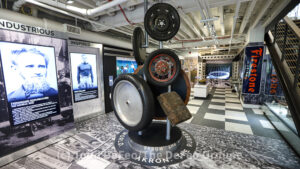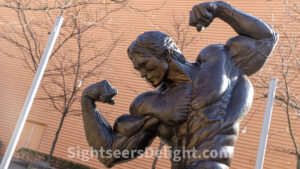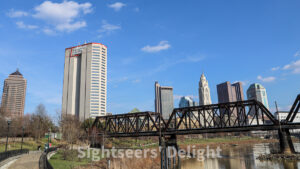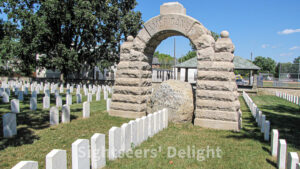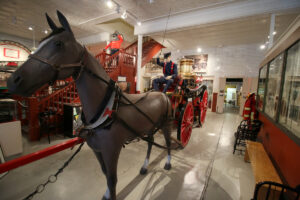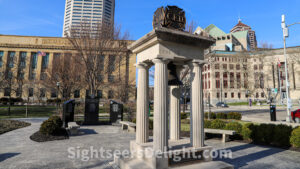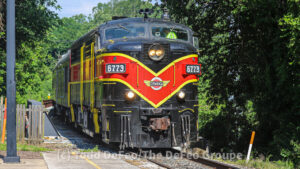The Akron Civic Theatre, originally opened as the Loew’s Theatre, is one of downtown Akron’s most celebrated landmarks and a rare surviving example of a 1920s atmospheric movie palace. Designed by renowned architect John Eberson, the theatre immerses audiences in a whimsical Mediterranean courtyard setting, complete with twinkling stars and drifting clouds projected across the domed ceiling. Seating more than 3,000 guests, the Civic is the only remaining theater of the 11 originally built by entertainment pioneer Marcus Loew, founder of the Loew’s theater chain.
44308
The new Akron History Center opened on Saturday, April 5, 2025, in downtown Akron at 172 South Main Street. Its mission is to create an enduring, free, museum-quality exhibit about Akron’s history. Operated by the Akron-Summit County Public Library in collaboration with the Summit County Historical Society and the non-profit Akron History Center, incorporated in 2023, the Akron History Center features more than 60 exhibits showcasing more than 100 historical artifacts, accompanied by stories told on over 30 video screens. Akron History Center, governed by a 15-member board of volunteers, raised $2.2 million. The initial investment was a $500,000 grant from Akron, followed by support from Akron’s foundations, businesses and local residents. The Akron History Center became possible when the Bowery Development Group acquired six historic buildings on Main Street in 2016.
Barrie Projects of Cleveland Heights conceived the design of the center. Dennis and Kathy Barrie also created the International Spy Museum in Washington, D.C., the National Museum of Organized Crime & Law Enforcement in Las Vegas, the U.S. Olympic and Paralympic Museum in Colorado Springs, the Maltz Museum of Jewish Heritage, and the National Museum of Psychology in Akron. Communication Exhibits of Canal Fulton designed and fabricated the exhibits. The company has created exhibits for industry and museums for more than 40 years.
44308
The statue of Arnold Schwarzenegger sits outside the Greater Columbus Convention Center, where it has stood since 2014. The bronze sculpture was originally erected outside the Franklin County Veterans Memorial in 2012, before being relocated and rededicated to its current location. Schwarzenegger, Ohio Gov. John Kasich, and Columbus Mayor Michael B. Coleman attended the ceremony.
Battelle Riverfront Park is a 4.1-acre park near Columbus City Hall in downtown Columbus, Ohio. The park was established in 1983. It is named after Gordon Battelle and was funded by the Battelle Memorial Institute.
43215
During the Civil War, Camp Chase, named for Salmon P. Chase, the Secretary of the Treasury under President Abraham Lincoln and a former governor of Ohio, was home to a military training camp for Union troops and one of the largest Confederate prisons. The first occupants of Camp Chase’s prison were political prisoners, but during the Civil War, as many as 25,000 Confederate soldiers passed through the camp, which was built to house 3,500-4,000 prisoners. By the end of January 1865, the prison held more than 9,400 prisoners. Today, the only remnant of the camp are the graves of 2,260 Confederate soldiers, buried in quarters so tight their headstones nearly touch one another. In the middle stands a monument — with the word “Americans” engraved into its “memorial arch.”
The Central Ohio Fire Museum & Learning Center opened in 2002 inside the restored historic Columbus Engine House (No.16) dating to 1908. In addition to historic engines and equipment, the museum aims to educate visitors about the dangers of fire and features a Safety Kitchen and a Safety Bedroom showing potential hazards and how to escape in an emergency.
43215
The Columbus Firefighters Memorial, designed by Lieutenant Ed Nothacker and erected in 1958, commemorates firefighters who died while serving. The memorial was dedicated on April 13, 1958, and rededicated on October 16, 1988. The monument, which features an eternal flame on top of Greek columns, was surveyed by the Smithsonian Institution’s “Save Outdoor Sculpture!” program in 1993.
43215
Home to more than 10,000 animals representing over 600 species from around the globe, the Columbus Zoo and Aquarium leads and inspires by connecting people and wildlife. The Zoo complex is a recreational and education destination that includes the 22-acre Zoombezi Bay water park and 18-hole Safari Golf Course. The Columbus Zoo and Aquarium also operates The Wilds, a 10,000-acre conservation center and safari park located in southeastern Ohio. The Zoo is a regional attraction with global impact; annually contributing $4 million of privately raised funds to support conservation projects worldwide.
43065
The Cuyahoga Valley Scenic Railroad offers a unique way to explore the natural beauty of the Cuyahoga Valley National Park as it winds between Akron and the greater Cleveland area. Originally opened in 1880 by the Valley Railroad Company, the line was purchased by the National Park Service in 1987 to enhance access to the park and attract more visitors to the growing recreation area. Excursion service resumed the following year, and by 1994 the operation was reorganized under its current name as the Cuyahoga Valley Scenic Railroad. Today, CVSR runs a variety of seasonal and themed trips with vintage diesel locomotives and classic passenger cars, offering an unforgettable rail experience through a scenic landscapes.
The Denison University Cemetery, also known as College Cemetery, was established in 1833 for presidents and professors who want to be interred on campus.
43023

